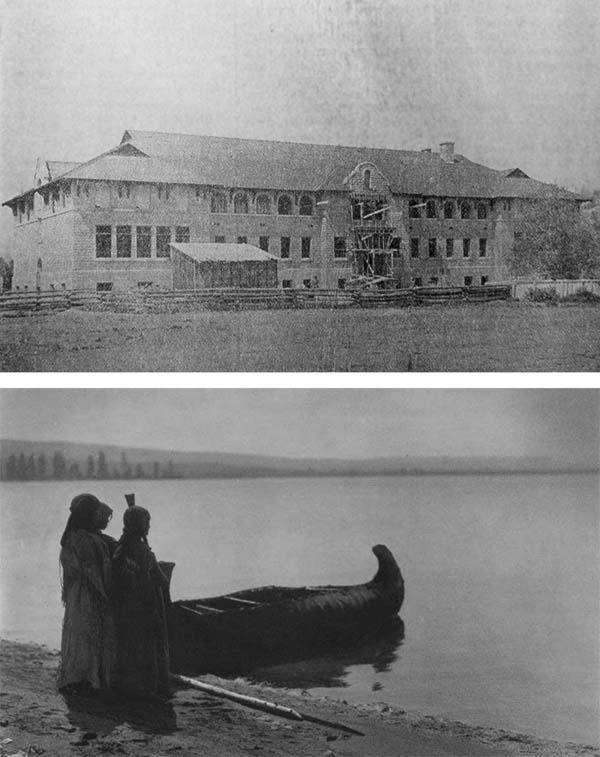Construction of the St. Eugene Indian Industrial School began on the 26th day of July, 1911. The following (edited for space) is excerpted from the Cranbrook Herald newspaper of Dec.19 1912. It reflects what might be termed a "progressive" view of the day, a view that saw residential schools as a positive step forward. There were differing views of course.
"The contract for the St. Eugene Mission Industrial School is about completed and the handsome structure will very shortly be occupied by the Indian boys and girls who are presently inadequately accommodated in the old buildings. The dominion's care of its Indian wards has always been a subject of earnest concern upon the part of those in authority and, in providing these handsome and commodious quarters for the Indian children of S.E. Kootenay, the department is extending its useful work along the healthiest lines. Bear in mind that the Department of Indian Affairs is a trustee in charge of the affairs of the Indian population of this country and is also their guardian as well as acting as a responsible, reliable and respected "mediator" between them and all parties; it is responsible for their education, mentally, morally and physically. No small undertaking in view of the numerous and varied interests ever contending to destroy a noble, much-abused and misjudged race of humanity.
In this work the Department has hitherto received splendid, most generous and thoroughly competent assistance from the various religious bodies through their missionaries. These bodies have borne a large portion of the cost of maintaining the numerous missions and schools either directly or indirectly and the same co-operation is likely to continue indefinitely. But the ever-changing conditions of modern civilization keeps raising the standards for the white population and naturally the department of Indian Affairs is obliged to improve its methods and aim at higher achievements in its dealing with and in behalf of the Indians. Otherwise, it would be untrue to its trust, the record of which is the secret of its excellent control of that race of people. To lose the respect of the Indians would be disastrous as well as a blot upon our civilization. Such is not to be allowed. Consequently the department has been persistent in requiring of the religious bodies in charge of the missions and schools higher and ever better training along sanitary, moral and eduacational lines, which requirements have been met as far as possible with the means placed at their disposal by the department, but there came a stage when it became evident that it would be impossible to continue without some improvements in the buildings and appliances supplied by the department generally or else the customary methods of educating the Indians would have to be altered. Having secured much more satisfactory results in its methods of handling the Indian affairs with its proven policy than had the country to the south of us, it was therefore accepted as natural that the present policy should by maintained and the necessary steps taken to make this possible, especially in view of the fact that the Canadian government has spent much less per capita on its Indian population than the United States and accomplished such better results. It also had ample funds available to carry out its contemplated improvements.
In deciding upon its future policy it was wisely guided by the advice of the missionaries collaborating in a convention held at Ottawa in 1910, at which it was decided that the department should renew or replace many of its old Mission buildings and in doing so that the new quarters in each case should be of such a size, construction and type as to be suitable for the purpose, permanent and capable of enlargement as conditions might require
In adopting such a policy the missionaries were to continue to use their best endeavors to meet the requirements of the department in the training of the Indian children. The boys are to be given manual training and the girls domestic science in addition to the branches already taught along other lines. This meant a new departure in the type of buildings for good business as well and it was decided to have all future buildings of the highest type. In deciding the matter as to which of the many Industrial Schools would have the first new building, the department did not overlook merit as well as necessity. The result was that the Kootenays, owing to the splendid showing and generally good reputation they had made in the comparatively brief period of their contact with the whites and also on account of the dilapidated condition of their school buildings were given the preference and the first of these modern school buildings is now located and ready for use upon their reserve at St. Eugene Mission."
In Nov. 2005, the Canadian Courts approved a residential school settlement for former students and families providing monetary compensation for students who lived at the schools across Canada, allowing $10,000.00 for the first year plus $3,000.00 for each school year after that. It further offered a process to allow those who suffered sexual or serious physical abuses causing serious psychological effects to receive between $5000 – 275,000.00 each. Money was also allotted for programmes for former students and their families for healing, truth, reconciliation and commemoration of the schools and the abuses suffered.
Next week: The St. Eugene Residential School Part II
